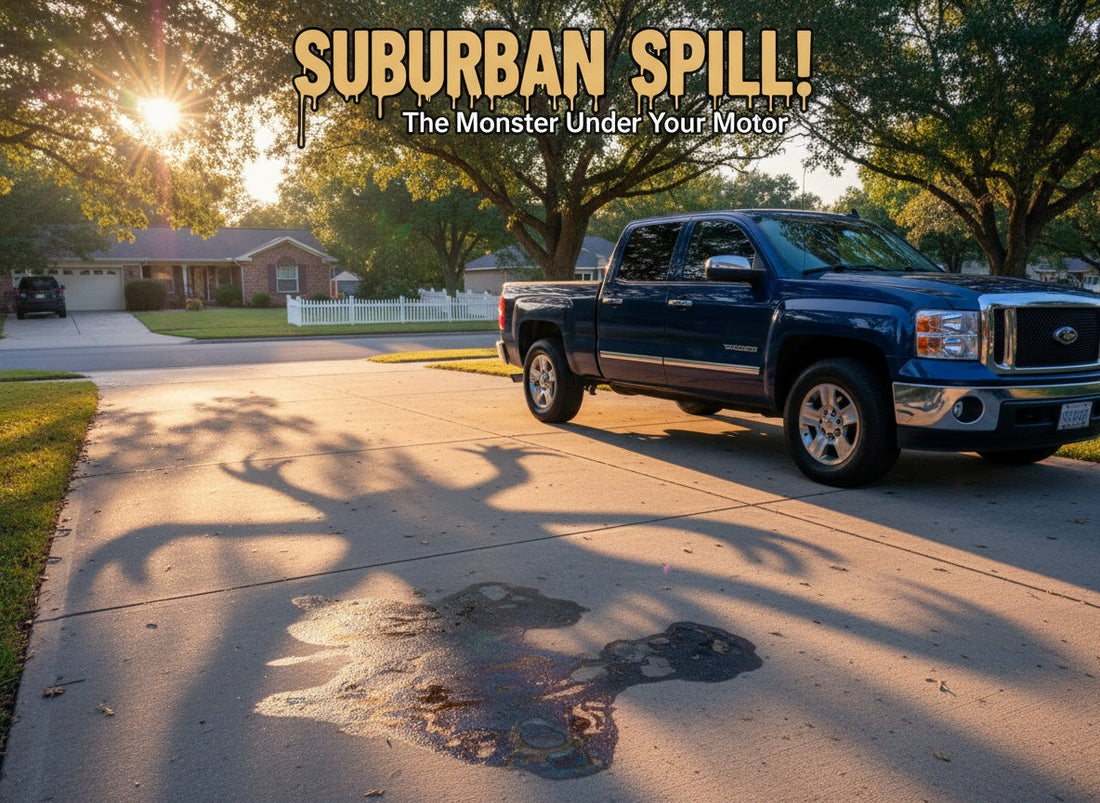
Oil Leaks 101: Why That “Little Oil Drip” Can Cost You $5,000+
Share
Oil Leak, now what?
If you’ve spotted a few dark drops under your car, you might be tempted to shrug and slide a piece of cardboard underneath. The truth: “just a drip” is how costly repairs, stained driveways, and awkward parking-lot moments begin. Today we’ll break down why oil leaks escalate—and how a simple, on-vehicle solution can stop the mess anywhere you park.
What Makes a Small Leak a Big Deal
- Escalating wear: Oil is your engine’s lifeblood. Even slow loss raises heat and friction, accelerating wear on seals and internals if it isn't monitored and added when needed.
- Mess compounds: Wind and road spray spread drips across your undercarriage, leading to grime buildup and hard-to-trace leak paths.
- Concrete and asphalt stains: Oil soaks into driveways, travels through pores, and leaves long-lasting blemishes that take serious scrubbing (or etching) to remove.
- Compliance headaches: Many HOAs and landlords can fine for persistent oil stains. Some public and private lots post no-leak rules.
- Environmental impact: Oil runoff into storm drains contaminates waterways. Even small leaks add up across neighborhoods.
Why Old “Fixes” Fall Short
- Cardboard: Only works at home—until you move the car. Soaks water and blows away. Not exactly curb-appeal friendly.
- Drip pans and floor mats: Helpful in a garage, but useless at the grocery store, workplace, or on a road trip. You have to place them perfectly every time.
- “Ignore it and it’ll stop”: It won’t. Heat cycles can make intermittent leaks hide, but they rarely fix themselves.
A Smarter Approach: On-Vehicle Containment
Instead of chasing drips on the ground, catch them at the source—under the vehicle—so protection goes wherever you drive. The Oil Jock mounts in minutes and uses hydrophobic pads to absorb oil while repelling water. Translation: rain runs off, oil gets captured. Each pad holds nearly a quart of oil, so you’ve got capacity for small leaks and peace of mind for long drives, and the pad can be easily changed at any time.
Key Advantages of On-Vehicle Containment
- Always with you: Protects your driveway, your job’s parking lot, hotel spots, and campgrounds.
- Cleaner reputation: No embarrassing puddles under your ride (or a customer’s test drive).
- Simple upkeep: Inspect periodically and replace the pad at oil changes. Low time, low cost.
- Built to last: Durable, heat-resistant, fiberglass■infused nylon housing stands up to daily driving.
When to Repair vs. Contain
- Repair now if: The leak is severe (rapid drops on the ground), there’s smoke, or you’re losing oil quickly.
- Contain smartly if: The leak is slow, the vehicle is older, a major repair doesn’t make financial sense, or you need time to plan repairs without making a mess.
Quick Oil Jock DIY Checklist
- Check pad saturation monthly, or more frequently if you notice fresh leaks.
- Check for contact or abrasion after rough-road use.
- Perform absorbent pad swaps simultaneously with oil changes for an easy routine.
The Bottom Line
A “little oil spot” can become a big, expensive headache. On-vehicle containment keeps your driveways clean, your neighbors happy, and your trip plans intact—while you decide if and when to book repairs.
Protect your car and your driveway with Oil Jock: https://oiljock.store/products/oil-jock
#carcare #oilleak #cleandriveway #carhack #carcaretips #rvlife #driveway cleaning #automotive #classiccar #musclecar
